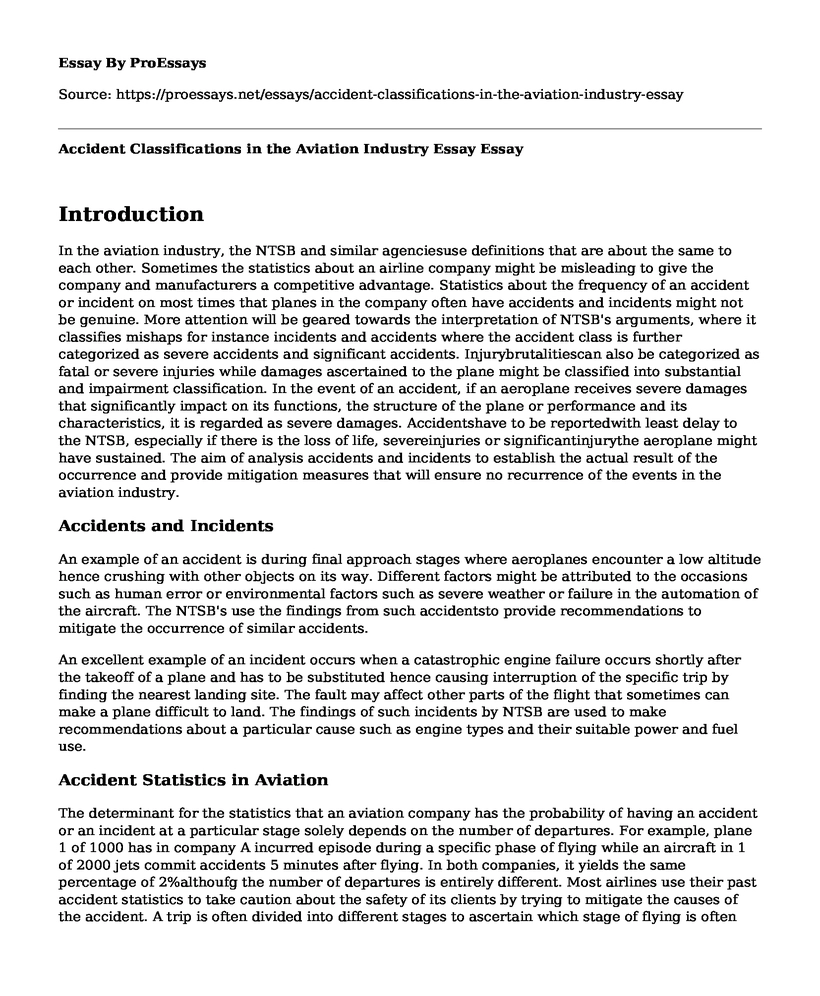Introduction
In the aviation industry, the NTSB and similar agenciesuse definitions that are about the same to each other. Sometimes the statistics about an airline company might be misleading to give the company and manufacturers a competitive advantage. Statistics about the frequency of an accident or incident on most times that planes in the company often have accidents and incidents might not be genuine. More attention will be geared towards the interpretation of NTSB's arguments, where it classifies mishaps for instance incidents and accidents where the accident class is further categorized as severe accidents and significant accidents. Injurybrutalitiescan also be categorized as fatal or severe injuries while damages ascertained to the plane might be classified into substantial and impairment classification. In the event of an accident, if an aeroplane receives severe damages that significantly impact on its functions, the structure of the plane or performance and its characteristics, it is regarded as severe damages. Accidentshave to be reportedwith least delay to the NTSB, especially if there is the loss of life, severeinjuries or significantinjurythe aeroplane might have sustained. The aim of analysis accidents and incidents to establish the actual result of the occurrence and provide mitigation measures that will ensure no recurrence of the events in the aviation industry.
Accidents and Incidents
An example of an accident is during final approach stages where aeroplanes encounter a low altitude hence crushing with other objects on its way. Different factors might be attributed to the occasions such as human error or environmental factors such as severe weather or failure in the automation of the aircraft. The NTSB's use the findings from such accidentsto provide recommendations to mitigate the occurrence of similar accidents.
An excellent example of an incident occurs when a catastrophic engine failure occurs shortly after the takeoff of a plane and has to be substituted hence causing interruption of the specific trip by finding the nearest landing site. The fault may affect other parts of the flight that sometimes can make a plane difficult to land. The findings of such incidents by NTSB are used to make recommendations about a particular cause such as engine types and their suitable power and fuel use.
Accident Statistics in Aviation
The determinant for the statistics that an aviation company has the probability of having an accident or an incident at a particular stage solely depends on the number of departures. For example, plane 1 of 1000 has in company A incurred episode during a specific phase of flying while an aircraft in 1 of 2000 jets commit accidents 5 minutes after flying. In both companies, it yields the same percentage of 2%althoufg the number of departures is entirely different. Most airlines use their past accident statistics to take caution about the safety of its clients by trying to mitigate the causes of the accident. A trip is often divided into different stages to ascertain which stage of flying is often prone to accidents and incidents, such as takeoffs, climbing, finishingslants, and landings. Another statistical error that may occur is comparing the statistics of planes in the aviation industry without considering the actual sizes of the flight.
References
Delta Air Lines Flight 191 Aviation Accident Report AAR-86-05 - NTSB Home. (n.d.). Retrieved on 15thJune 2018 fromhttp://www.ntsb.gov/Investigations/AccidentReports/Pages/AAR8605.aspx
NTSB Accident and Incident Reporting Requirements. (n.d.). Retrieved on 28th January 2016 fromhttps://www.nbaa.org/ops/safety/ntsb/
Cite this page
Accident Classifications in the Aviation Industry Essay. (2022, Jun 17). Retrieved from https://proessays.net/essays/accident-classifications-in-the-aviation-industry-essay
If you are the original author of this essay and no longer wish to have it published on the ProEssays website, please click below to request its removal:
- American Airline Labor: Article Critique
- Case Study of Philippine Airline and Ryan Air
- Paper Example on Competing for Profit: Alaska Airlines and Low-Cost Rivals
- Paper Example on Aircraft Cockpit: Evolution Over Time
- Paper Example on Cockpit: Aircraft's Command Center for Navigation & Control
- Emirates Airlines: Adopting Porter's 5 Strategies to Tackle Threats from Competitors - Essay Sample
- Paper Example on Flight Simulators: Low & High Fidelity Training







